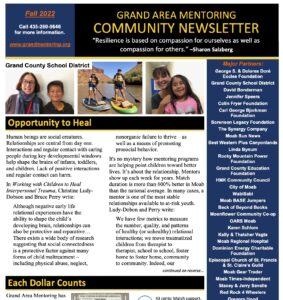Fall 2022 Community Newsletter
Opportunity to Heal
Human beings are social creatures. Relationships are central from day one. Interactions and regular contact with caring people during key developmental windows help shape the brains of infants, toddlers, and children. Lack of positive interactions and regular contact can harm.
In Working with Children to Heal Interpersonal Trauma, Christine Ludy-Dobson and Bruce Perry write:
Although negative early life relational experiences have the ability to shape the child’s developing brain, relationships can also be protective and reparative… There exists a wide body of research suggesting that social connectedness is a protective factor against many forms of child maltreatment – including physical abuse, neglect, nonorganic failure to thrive – as well as a means of promoting prosocial behavior.
It’s no mystery how mentoring programs are helping point children toward better lives. It’s about the relationship. Mentors show up each week for years. Match duration is more than 600% better in Moab than the national average. In many cases, a mentor is one of the most stable relationships available to at-risk youth. Ludy-Dobon and Perry write:
We have few metrics to measure the number, quality, and patterns of healthy (or unhealthy) relational interactions; we move traumatized children from therapist to therapist, school to school, foster home to foster home, community to community. Indeed, our systems often exacerbate or even replicate the relational impermanence and trauma of the child’s life. We expect ‘therapy’ – healing – to take place in the child via episodic, shallow relational interactions with highly educated but poorly nurturing strangers. We undervalue the powerful therapeutic impact of caring teacher, coach, neighbor, grandparent, and a host of other potential ‘cotherapists.’
This notion fits into the emerging view of mentor as paraprofessional, where they employ special strategies in a caring, helpful, and quasi-therapeutic way. As Dr. Jean Rhodes writes in her book, Older and Wiser, “formal mentors frequently draw on a wide array of established therapeutic techniques. For example, as mentors encourage their mentees to think and act in more adaptive ways, they may draw on principles of cognitive behavioral therapy (CBT), which help young people develop the skills needed to effectively address many of the most common psychological problems.”
With this in mind, Grand Area Mentoring continues to provide advanced training to mentors on relevant topics, such as:
- Trauma-Informed Mentoring
- Self-Regulation
- Motivational Interviewing
- Strategic Self-Disclosure
- Cultural Awareness and Sensitivity
- Goal Setting and more.
The risk profiles of children referred for mentoring suggest they have elevated potential for social, emotional, and academic dysfunction. Like any single strategy in a complex world, mentoring is not a panacea. It fits into a context where youth thrive thanks to support from a variety of directions. As risk factors mount in a child’s life, so too can healing and preventative measures. Mentoring is an affordable, proven intervention that leverages the power of relationship to combat harmful influences – past, present, and future. Ludy-Dobon and Perry write:
…healthy caregiving and strong attachments can help protect children from the lasting impact of traumatic events. That is not to say that all the scars disappear or that the memories of trauma no longer exist, only that the reestablishment of predictable routines, reconnections with attentive, attuned, committed caregivers, and solid therapeutic treatment provide the opportunity for children to heal.

[button url=”https://grandmentoring.org/wp-content/uploads/Community-Newsletter-Fall-2022.pdf” target=”_blank” style=”red” size=”medium” type=”square”]View Newsletter [/button]
